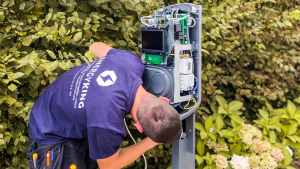Electric vehicles (EVs) are quietly revolutionizing the automotive world. As EVs become increasingly popular, the infrastructure and technologies associated with them are also evolving. One of the most exciting developments in this area is the emergence of bi-directional charging stations, which have the potential to transform the way we use electric vehicles and manage energy.
What are bidirectional charging stations?
Bidirectional charging stations, also known as Vehicle-to-Grid (V2G) charging stations, are advanced charging stations that can not only deliver power to your electric vehicle, but also have the ability to feed electricity back to the grid when needed. This is an exciting step forward in the world of sustainable mobility and energy management.
Benefits of bi-directional charging stations
1. Energy storage and feed back to the grid
One of the most notable advantages of bi-directional charging stations is their ability to store electricity in your EV's battery system and feed this stored energy back into the grid when demand is high. This helps accommodate spikes in energy demand and improve grid stability, which is essential in a world where renewable energy sources such as solar and wind power are becoming the norm.
2. Cost savings for electric vehicle owners
Electric vehicle owners can benefit from bi-directional charging stations by storing electricity during periods of low rates and using it when rates are high. This can provide significant cost savings and reduce the payback period for EVs.
3. Emergency power supply
Bidirectional charging stations can also serve as an emergency power supply for homes and businesses during power outages. Your EV can act as a mobile power source, adding an extra layer of reliability and security to your electricity supply.
Latest developments
While two-way charging technology is developing rapidly, there are some notable recent developments that make the future even more promising:
1. Collaborations between automakers and energy companies.
More and more automakers are partnering with power companies to offer bi-directional charging solutions to their customers. These collaborations allow electric vehicle owners to seamlessly use V2G technology.
2. Standardization of V2G protocols.
There are global efforts to develop common standards for V2G protocols, which will facilitate interoperability between different charging station and vehicle manufacturers. This will accelerate the adoption of bi-directional charging technology.
Conclusion
Bidirectional charging stations are poised to transform the future of sustainable mobility and energy management. With the ability to store electricity, feed it back to the grid and serve as an emergency power supply, these advanced charging stations promise to play a crucial role in our pursuit of a greener and more resilient future.
Developments in V2G technology, growing collaborations between industries and standardization efforts give us cause for optimism. If consumers, automakers and energy companies continue to invest in this exciting technology, we can envision a future where our electric vehicles are not only cleaner, but also play an active role in managing our energy infrastructure.
So, if you are looking for a more environmentally friendly and cost-effective way to charge your electric vehicle, it may be time to consider switching to bi-directional charging technology. It's not only good for the environment, but also good for your wallet. The future of electric driving is brighter than ever before, thanks to these innovative charging stations.





